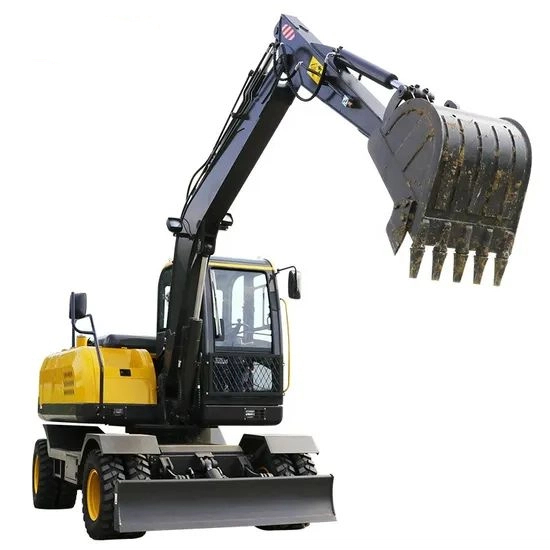The following is a detailed introduction to wheeled excavators:
Basic Introduction
Definition: A wheeled excavator is an earth-moving machine that uses tires as its traveling components, referred to as "wheel excavator" for short. It uses a bucket to excavate materials that are higher or lower than the bearing surface of the machine, and loads them into transport vehicles or unloads them to stockyards.
Working Principle: A hydraulic wheeled excavator is driven by a diesel engine or an electric motor to power two hydraulic main pumps, which generate high-pressure oil and deliver it to the multi-way valve. Controlled by the pilot control valve, the high-pressure oil is sent to relevant hydraulic actuators through the multi-way valve to drive the corresponding mechanisms for operation. Its traveling generally adopts hydraulic-mechanical transmission. High-pressure oil flows from the central swivel to the traveling hydraulic motor, which directly drives the gearbox, and then drives the vehicle to travel through the transmission shaft and drive axle.
Overall Structure: It is mainly composed of working devices, cab, slewing mechanism, power device, transmission and control mechanism, chassis, and auxiliary equipment. The tire chassis consists of a frame, supports, gearbox, hydraulic motor, front and rear axles, tires, etc., and is assembled with the slewing body. The working device is mainly composed of a boom, arm, bucket, connecting rod, and other parts.

Performance Characteristics
Strong Mobility: It has a fast traveling speed. The maximum traveling speed of foreign wheeled excavators is mostly 25-40 km/h, and that of domestic ones is mostly 20-35 km/h. It can transfer over long distances by itself, quickly replace various working devices, and move rapidly between different construction sites without the need for a trailer, which can effectively save time and transportation costs.
High Operational Efficiency: Although its pure excavation efficiency may be slightly inferior to that of crawler excavators of the same grade, in terms of comprehensive operational efficiency, especially in small and medium-sized projects that require frequent transfers, the advantage of the wheeled excavator's fast transfer can make up for the gap in excavation efficiency, resulting in high overall operational efficiency.
Good Road Adaptability: The tire-type traveling device distributes pressure on the road surface relatively evenly and will not cause significant damage to hard road surfaces like crawler excavators. Therefore, it has better adaptability when traveling and operating on hard road surfaces such as urban roads and highways, and is suitable for municipal maintenance projects, etc.
High Operational Comfort: The cab usually has good sealing and shock absorption performance, equipped with a comfortable seat, air conditioning system, and good visibility, etc., which can provide operators with a relatively comfortable working environment and reduce fatigue from long-term operations.
Versatility: It can quickly replace various working devices, such as (crushers), hydraulic shears, grabs, drilling mechanisms, etc. By replacing different attachments, it can realize multiple operational functions such as excavation, crushing, grabbing, shearing, and drilling, meeting the needs of different projects.
Application Fields
Municipal Engineering: It is widely used in urban water pipe maintenance, drainage pipe laying, cable trench excavation, road repair, street lamp foundation construction, landscaping, etc. Its flexible and mobile characteristics enable it to quickly move and work in environments such as narrow urban streets and residential areas, with little damage to urban roads.
Highway and Transportation Construction: It can be used for road subgrade excavation, side ditch digging, bridge foundation construction, road surface breaking, etc. In expressway maintenance projects, wheeled excavators can quickly reach the construction site for emergency repair operations, such as repairing collapsed road surfaces and clearing landslides.
Industrial and Civil Construction: In projects such as industrial plant construction and residential construction, it is used for site leveling, foundation excavation, earth moving, etc. Especially in some small construction sites or relatively flat terrain areas, wheeled excavators can give full play to their advantages of mobility and flexibility, improving construction efficiency.
Agricultural and Water Conservancy Engineering: In farmland water conservancy construction, it can be used for excavating irrigation channels, drainage ditches, building dams, etc. In rural land consolidation projects, wheeled excavators can also level farmland and dig field ridges, improving agricultural production conditions.





